AI-Enabled IoT Framework for Leakage Detection and Its Consequence Prediction during External Transportation of LPG
Abstract
1. Introduction
- The heat dispersion phenomena during leakage of LPG are studied using theoretical and computational fluid dynamics (CFD) simulation-based approaches. A database is created for the diameter of the risk contour based on the CFD simulation with varied environmental conditions.
- Based on the database, an AI model is developed to predict the effects of any accidental leakage from an LPG-filled tanker truck in terms of the diameter of the risk contours and the degree of severity (heat flux) for any arbitrary environmental condition.
- An IoT framework is developed that deploys the proposed AI model at the edge devices in order to convey the accident location and its probable consequences, in terms of the diameter of the risk contour, to the disaster management team immediately.
2. Proposed AI Model
2.1. Behavioral Study of the Heat Dispersion
2.2. Problem Formulation
2.3. Dataset Preparation
2.4. Exploratory Data Analysis and Feature Selection
2.5. Model Selection
2.6. Model Training and Validation
3. Proposed IoT Framework
- Continuously sense the parts per million (ppm) level of LPG outside the tanker. Based on the measured ppm level, it detected the occurrence of any accidents.
- Upon the occurrence of an accident, predict probable consequences like jet-fire or fireball. For the probable consequence predicted, it evaluated the diameter of risk contours with various degrees of heat flux intensities.
- Report the precise information to the appropriate authority present at the remote location.
4. Prototype Testing and Discussion
5. Conclusions
Author Contributions
Funding
Acknowledgments
Conflicts of Interest
References
- International Program on Chemical Safety (IPCS) and CEC, Commission of the European Communities, International Chemical Safety Cards. Available online: https://apps.who.int/iris/bitstream/handle/10665/175580/WHA45_16_eng.pdf?sequence=1 (accessed on 2 January 2022).
- International Labor Organization. Encyclopedia of Occupational Health and Safety, Vol I–III; International Labor Organization: Geneva, Switzerland, 1983. [Google Scholar]
- United Nations. Transport of Dangerous Goods, 8th ed.; United Nations: New York, NY, USA, 1993.
- Wenxue, C.; Hengpeng, W.; Shangjiang, S.; Lilu, A. An improved hazardous material road transportation accident rate analysis model. In Proceedings of the International Conference on Logistics Systems and Intelligent Management (ICLSIM), Harbin, China, 9–10 January 2010; pp. 1081–1085. [Google Scholar]
- Park, K.; Mannan, M.S.; Jo, Y.-D.; Kim, J.-Y.; Keren, N.; Wang, Y. Incident analysis of Bucheon LPG filling station pool fire and BLEVE. J. Hazard. Mater. 2006, 137, 62–67. [Google Scholar] [CrossRef] [PubMed]
- Erhan, E.; S Tjandra, S.A.; Verter, V. Handbook in Operations Research and Management Science; Chapter 9 Hazardous Materials Transportation; Barnhart, C., Laporte, G., Eds.; Elsevier: Amsterdam, The Netherlands, 2007; Volume 14, pp. 539–621. ISBN 9780444513465. [Google Scholar] [CrossRef]
- Good Industry Practices for LP Gas Bulk Road Tanker Management. Available online: https://www.wlpga.org/wpcontent/uploads/2013/05/GBP-Bulk-Road-Tanker-Management-20131.pdf (accessed on 15 July 2023).
- Annual Report on Liquefied Petroleum Gas (LPG) Related Accidents, 2013 Version, The High-Pressure Gas Safety Institute of Japan. Available online: https://www.khk.or.jp/Portals/0/resources/english/dl/annual_report_lpg_2013.pdf (accessed on 12 October 2022).
- Dulebenets, M.; Pasha, J.; Abioye, O.; Kavoosi, M.; Ozguven, E.; Moses, R.; Sando, T. Exact and heuristic solution algorithms for efficient emergency evacuation in areas with vulnerable populations. Int. J. Disaster Risk Reduct. 2019, 39, 101114. [Google Scholar] [CrossRef]
- Ray, P.; Mukherjee, M.; Shu, L. Internet of Things for Disaster Management: State-of-the-Art and Prospects. IEEE Access 2017, 5, 18818–18835. [Google Scholar] [CrossRef]
- Shu, L.; Mukherjee, M.; Pecht, M.; Crespi, N.; Han, S.N. Challenges and Research Issues of Data Management in IoT for Large-Scale Petrochemical Plants. IEEE Syst. J. 2018, 12, 2509–2532. [Google Scholar] [CrossRef]
- Du, Z.; Mao, Y.; Lu, M. Design and Implementation of Safety Management System for Oil Depot Based on Internet of Things. In Proceedings of the 2012 IEEE International Conference on Green Computing and Communications, Besancon, France, 20–23 November 2012; pp. 249–252. [Google Scholar] [CrossRef]
- Deng, J.L.; Chen, G.R. Research on Online Fault Diagnosis Model Based on IoT in Process Industry. Adv. Mater. Res. 2013, 765–767, 2089–2092. [Google Scholar] [CrossRef]
- Nivedhitha, S.; Padmavathy, A.P.; Susaritha, U.S.; Madhan, M.G. Development of multipurpose gas leakage and fire detector with alarm system. In Proceedings of the 2013 Texas Instruments India Educators′ Conference, Bangalore, India, 4–6 April 2013; pp. 194–199. [Google Scholar]
- Spiryakin, D.; Baranov, A.M.; Sleptsov, V. Design of Smart Dust Sensor Node for Combustible Gas Leakage Monitoring. In Proceedings of the 2015 Federated Conference on Computer Science and Information Systems (FedCSIS), Lodz, Poland, 13–16 September 2015. [Google Scholar] [CrossRef]
- Majder-Łopatka, M.; Węsierski, T.; Dmochowska, A.; Salamonowicz, Z.; Polańczyk, A. The Influence of Hydrogen on the In-dications of the Electrochemical Carbon Monoxide Sensors. Sustainability 2020, 12, 14. [Google Scholar] [CrossRef]
- Celesti, A.; Galletta, A.; Carnevale, L.; Fazio, M.; Ekuakille, A.; Villari, M. An IoT Cloud System for Traffic Monitoring and Ve-hicular Accidents Prevention Based on Mobile Sensor Data Processing. IEEE Sens. J. 2018, 18, 4795–4802. [Google Scholar] [CrossRef]
- Bhatti, F.; Shah, M.; Maple, C.; Islam, S. A Novel Internet of Things-Enabled Accident Detection and Reporting System for Smart City Environments. Sensors 2019, 19, 2071. [Google Scholar] [CrossRef]
- Kumar, N.; Acharya, D.; Lohani, D. An IoT-Based Vehicle Accident Detection and Classification System Using Sensor Fusion. IEEE Internet Things J. 2021, 8, 869–880. [Google Scholar] [CrossRef]
- Sánchez-Mangas, R.; García-Ferrrer, A.; de Juan, A.; Arroyo, A.M. The probability of death in road traffic accidents. How important is a quick medical response? Accid. Anal. Prev. 2010, 42, 1048–1056. [Google Scholar] [CrossRef]
- Gusev, M.; Dustdar, S. Going Back to the Roots—The Evolution of Edge Computing, An IoT Perspective. IEEE Internet Comput. 2018, 22, 5–15. [Google Scholar] [CrossRef]
- Bandopadhaya, S.; Dey, R.; Suhag, A. Integrated Healthcare Monitoring Solutions for Soldier using the Internet of Things with Distributed Computing. Sustain. Comput. Inform. Syst. 2020, 26, 100378. [Google Scholar] [CrossRef]
- Liao, C.; Shou, G.; Liu, Y.; Hu, Y.; Guo, Z. Intelligent traffic accident detection system based on mobile edge computing. In Proceedings of the 2017 3rd IEEE International Conference on Computer and Communications (ICCC), Chengdu, China, 13–16 December 2017; pp. 2110–2115. [Google Scholar] [CrossRef]
- Seal, A.; Bhattacharya, S.; Mukherjee, A. Fog Computing for Real-Time Accident Identification and Related Congestion Control. In Proceedings of the 2019 IEEE International Systems Conference (SysCon), Orlando, FL, USA, 8–11 April 2019; pp. 1–8. [Google Scholar] [CrossRef]
- Dulebenets, M.; Pasha, J.; Kavoosi, M.; Abioye, O.; Ozguven, E.; Moses, R.; Boot, W.; Sando, T. Multi-objective optimization model for emergency evacuation planning in geographical locations with vulnerable population groups. J. Manag. Eng. 2020, 36, 04019043. [Google Scholar] [CrossRef]
- Chakroborty, A.; Mannan, S.; Cagin, T. Multiscale Modeling for Process Safety Applications; Butterworth Heinemann: Oxford, UK, 2015. [Google Scholar]
- Marx, J.D.; Cornwell, J.B. The importance of weather variations in a quantitative risk analysis. J. Loss Prev. Process. Ind. 2009, 22, 803–808. [Google Scholar] [CrossRef]
- Gallego, V.; Rossi, M.; Brunelli, D. Unmanned aerial gas leakage localization and mapping using microdrones. In Proceedings of the 2015 IEEE Sensors Applications Symposium, Zadar, Croatia, 13–15 April 2015; pp. 1–6. [Google Scholar] [CrossRef]
- Shu, L.; Mukherjee, M.; Wu, X. Toxic gas boundary area detection in large-scale petrochemical plants with industrial wireless sensor networks. IEEE Commun. Mag. 2016, 54, 22–28. [Google Scholar] [CrossRef]
- Pontiggia, M.; Derudi, M.; Busini, V.; Rota, R. Hazardous gas dispersion: A CFD model accounting for atmospheric stability classes. J. Hazard. Mater. 2009, 171, 739–747. [Google Scholar] [CrossRef]
- Pontiggia, M.; Landucci, G.; Busini, V.; Derudi, M.; Alba, M.; Scaioni, M.; Bonvicini, S.; Cozzani, V.; Rota, R. CFD model simulation of LPG dispersion in urban areas. Atmospheric Environ. 2011, 45, 3913–3923. [Google Scholar] [CrossRef]
- Zadakbar, O.; Abbassi, R.; Khan, F.; Karimpour, K.; Golshani, M.; Vatani, A. Risk Analysis of Flare Flame-out Condition in a Gas Process Facility. Oil Gas Sci. Technol. 2011, 66, 521–530. [Google Scholar] [CrossRef]
- Bauwens, C.; Dorofeev, S. CFD modeling and consequence analysis of an accidental hydrogen release in a large-scale facility. Int. J. Hydrogen Energy 2014, 39, 20447–20454. [Google Scholar] [CrossRef]
- Kashia, E.; Mirzaeib, F.; Mirzaeib, F. Analysis of gas dispersion and ventilation within a comprehensive CAD model of an off-shore platform via computational fluid dynamics. J. Loss Prev. Process Ind. 2015, 36, 125–133. [Google Scholar] [CrossRef]
- Ahmadi, O.; Mortazavi, S.; Pasdarshahri, H.; Mohabadi, H. Consequence analysis of large-scale pool fire in oil storage terminal based on computational fluid dynamic (CFD). Process. Saf. Environ. Prot. 2019, 123, 379–389. [Google Scholar] [CrossRef]
- Shen, R.; Jiao, Z.; Parker, T.; Sun, Y.; Wang, Q. Recent application of Computational Fluid Dynamics (CFD) in process safety and loss prevention: A review. J. Loss Prev. Process. Ind. 2020, 67, 104252. [Google Scholar] [CrossRef]
- Kochkov, D.; Smith, J.; Alieva, A.; Wang, Q.; Brenner, M.; Hoyer, S. Machine learning–accelerated computational fluid dynamics. Proc. Natl. Acad. Sci. USA 2021, 118, e2101784118. [Google Scholar] [CrossRef] [PubMed]
- Yang, M.; Khan, F.; Lye, L. Precursor-based hierarchical Bayesian approach for rare event frequency estimation: A case of oil spill accidents. Process. Saf. Environ. Prot. 2013, 91, 333–342. [Google Scholar] [CrossRef]
- Liua, Z.; Maa, Q.; Cai, B.; Liua, Y.; Zheng, C. Risk assessment on deepwater drilling well control based on dynamic Bayesian network. Process Saf. Environ. 2021, 149, 643–654. [Google Scholar] [CrossRef]
- Vairo, T.; Pettinato, M.; Reverberi, A.; Milazzo, M.; Fabiano, B. An approach towards the implementation of a reliable resilience model based on machine learning. Process. Saf. Environ. 2023, 172, 632–641. [Google Scholar] [CrossRef]
- Assael, M.; Kakosimos, K. Fires, Explosions, and Toxic Gas Dispersions: Effects Calculation and Risk Analysis; CRC Press: Boca Raton, FL, USA, 2010. [Google Scholar]
- ALOHA Software. Available online: https://www.iafc.org/topics-and-tools/resources/resource/aloha-software (accessed on 9 April 2022).
- Alpaydin, E. Introduction to Machine Learning, 3rd ed.; PHI Learning Pvt Ltd.: Cambridge, MA, USA; The MIT Press: London, UK, 2016. [Google Scholar]
- Current Intelligence Bulletin #66: Derivation of Immediately Dangerous to Life or Health (IDLH) Values, The National Institute for Occupational Safety and Health (NIOSH). November 2013. In Retrieved 11 February 2018. Available online: https://www.cdc.gov/niosh/docs/2014-100/pdfs/2014-100.pdf (accessed on 19 June 2022).
- Material Safety Data Sheet, Gail (India) Limited. Available online: https://gailonline.com/pdf/Business_verticals/MSDS%20LPG.pdf (accessed on 20 September 2022).
- Guide to NEO-6M GPS Module with Arduino. Available online: https://randomnerdtutorials.com/guide-to-neo-6m-gps-module-with-arduino/ (accessed on 23 September 2022).
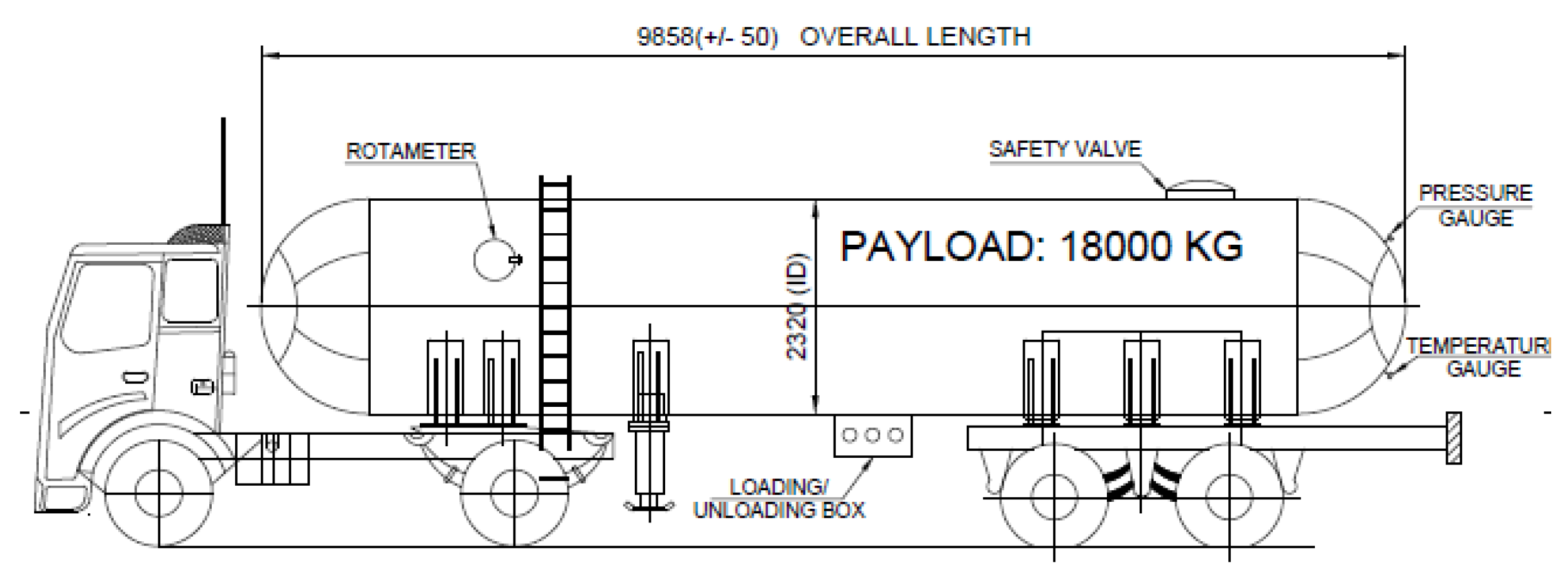
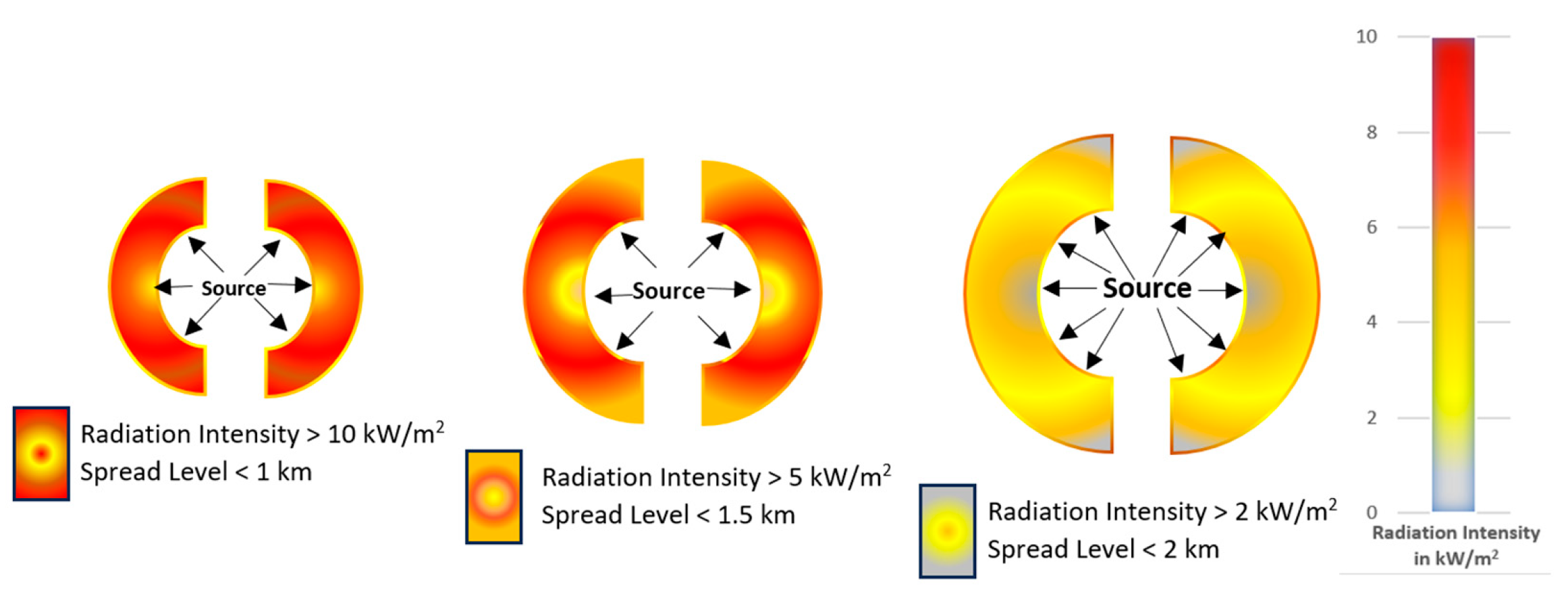


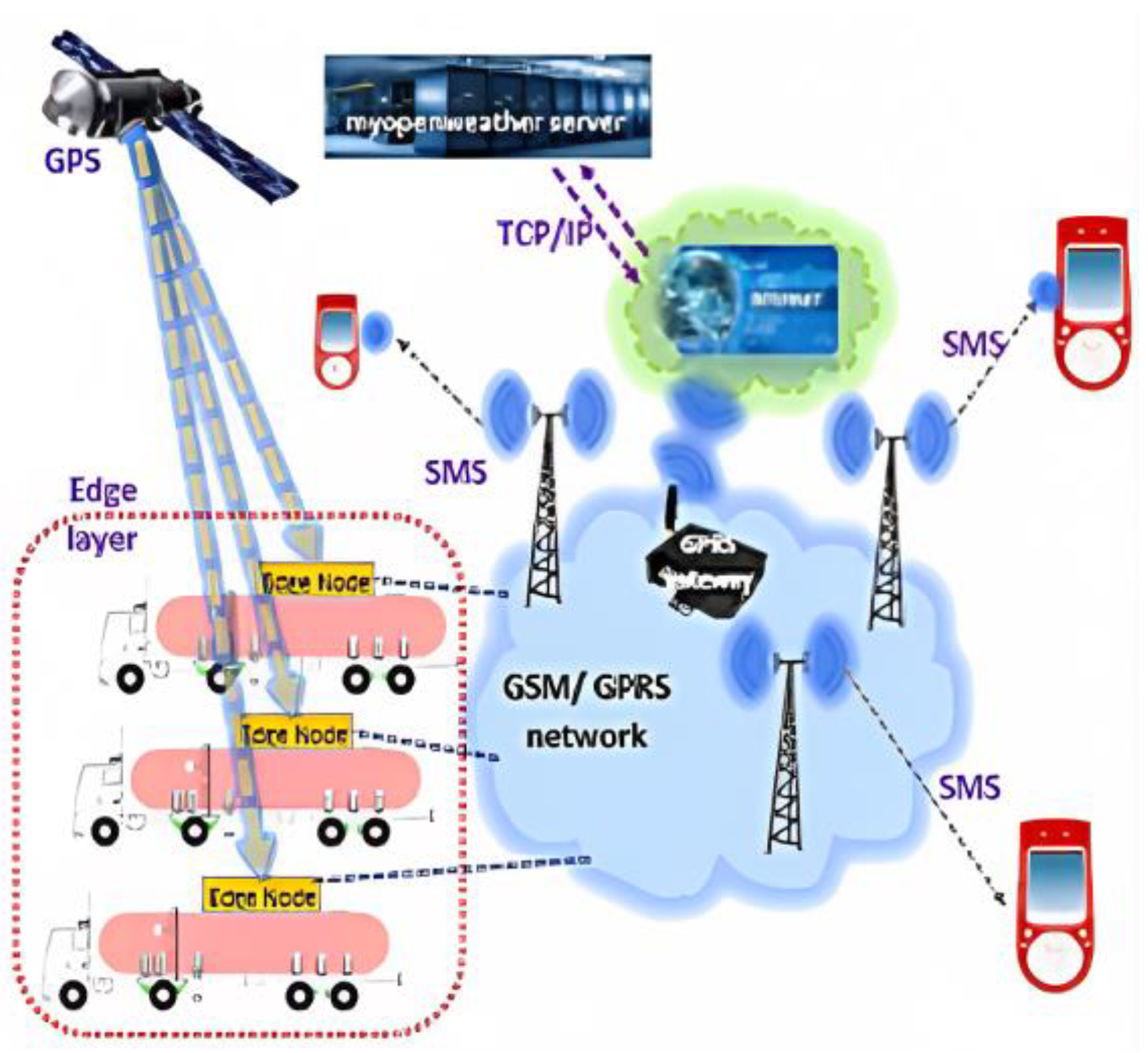
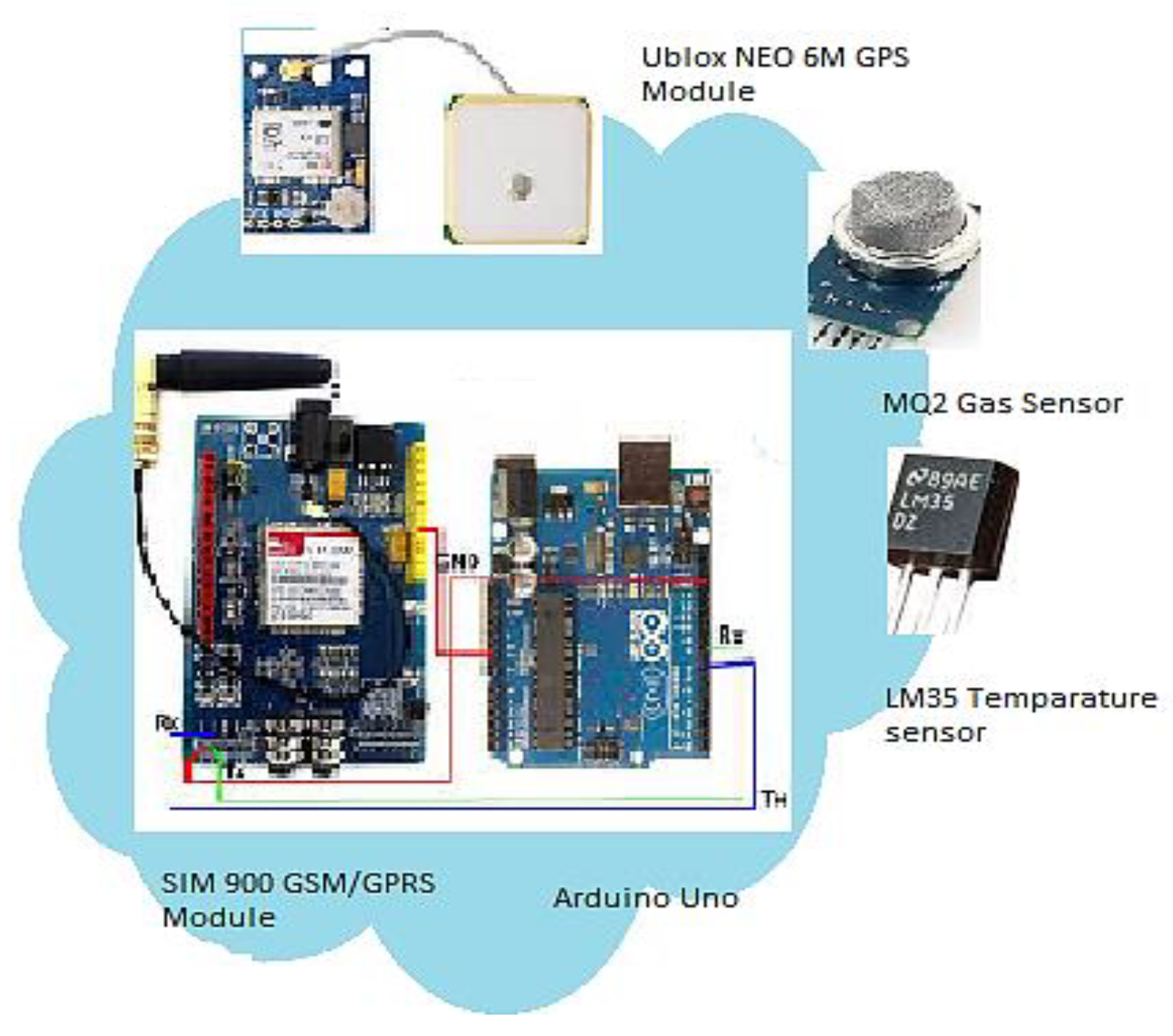
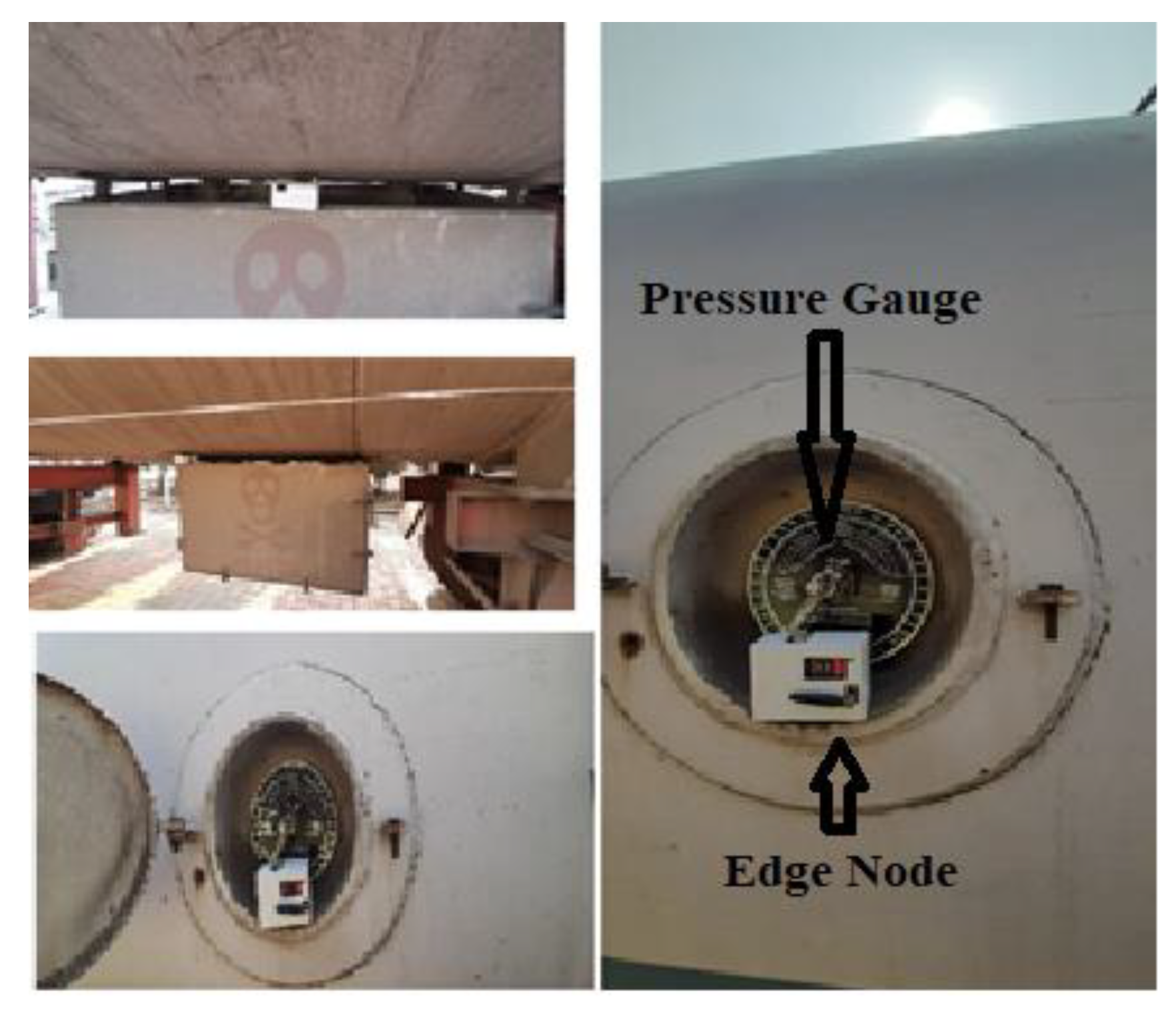


| Parameters | Specifications |
| Boiling Point (°C) | >−40 |
| Vapor Density (AIR = 1) | 1.5 |
| Specific Gravity (H2O = 1): | 0.51 to 0.58 at 50 °C |
| Flammability | Yes |
| Low Explosive Level (LEL) | 1.8% |
| Upper Explosive Level (LEL) | 12.8% |
| Acute Exposure Guideline Level | |
| AEGL-1 (10 min) | 10,000 ppm |
| AEGL-2 (10 min) | 17,000 ppm |
| AEGL-3 (10 min) | 33,000 ppm |
| Immediately dangerous to life or health (IDLH) air concentration | 19,000 ppm |
| Parameters | Specifications |
| Tank Diameter | 2.320 m |
| Tank Length | 9.858 m |
| Tank Contained | Liquid |
| Internal Storage Temperature | |
| Chemical Mass in Tank | 18 tons |
| % of Tank full | 88% |
| Input Parameters | ||||||||
|---|---|---|---|---|---|---|---|---|
| Jet-Fire | Fireball | |||||||
| TA (°C) | 2 | 5 | 10 | 2 | 5 | 10 | ||
| 30 | 4 | 50 | 98 | 141 | 219 | 643 | 908 | 1400 |
| 40 | 4 | 70 | 93 | 135 | 210 | 612 | 864 | 1300 |
| 50 | 8 | 20 | 102 | 144 | 219 | 637 | 898 | 1400 |
| Parameters | TA (°C) | (%) | Diameter of Risk Contour (m) | ||||||
|---|---|---|---|---|---|---|---|---|---|
| Jet-Fire (kW/m2) | Fireball (kW/m2) | ||||||||
| 10 | 5 | 2 | 10 | 5 | 2 | ||||
| Mean | 25 | 6.25 | 50 | 102.6 | 144.9 | 224.3 | 675.9 | 951.1 | 1497 |
| S.D. | 17.11 | 4.15 | 31.57 | 8.36 | 8.83 | 12.7 | 71 | 95.86 | 184.5 |
| 25th percentiles | 10 | 3.25 | 20 | 97 | 139 | 215 | 627 | 885 | 1400 |
| 50th percentiles | 25 | 6 | 50 | 103 | 145 | 224 | 662 | 935 | 1500 |
| 75th percentiles | 40 | 9 | 80 | 109 | 151 | 233 | 696 | 982 | 1700 |
| Parameters | Jet-Fire (kW/m2) | Fireball (kW/m2) | ||||
|---|---|---|---|---|---|---|
| 10 | 5 | 2 | 10 | 5 | 2 | |
| TA (°C) | −0.61 | −0.73 | −0.78 | −0.44 | −0.46 | −0.38 |
| 0.69 | 0.49 | 0.33 | ~0 | ~0 | ~0 | |
| (%) | −0.35 | −0.45 | −0.49 | −0.67 | −0.66 | −0.65 |
| Evaluation Parameter | ||||||
|---|---|---|---|---|---|---|
| 10 | 5 | 2 | 10 | 5 | 2 | |
| score | 0.975 | 0.96 | 0.95 | 0.97 | 0.95 | 0.88 |
| % of error margin | 4.37 | 4.39 | 4.52 | 6.32 | 6.12 | 14.3 |
| Parameters | ||||||
|---|---|---|---|---|---|---|
| 10 | 5 | 2 | 10 | 5 | 2 | |
| 106.94 | 155.39 | 244.44 | 748.50 | 1051.7 | 1653.2 | |
| −0.296 | −0.374 | −0.578 | −2.005 | −2.777 | −4.514 | |
| 1.396 | 1.038 | 1.002 | NA | NA | NA | |
| −0.103 | −0.139 | −0.216 | −0.750 | −1.018 | −1.706 | |
| Require: LPG leakage monitoring and alerting with location and probable consequences. Ensure: Real-time detection of accident, prediction of probable risk contour using real-time environmental data and sending of alert message with minimal delay. 1: Define API key of MyOpenWeather server 2: Define Calibration parameters of MQ2 gas sensor 3: Define Registered SIM number(s) to which the alert message to be sent 4: Define Arduino Uno GPIO pins for MQ2 gas sensor, LM35 temperature sensor, SIM900 GSM/GPRS module, Ublox NEO 6M GPS module. 5: PPM←PPM value of LPG TEMP←Skin temperature of tanker truck 6: Set threshold PPM value of LPG for imitating accident condition: Th 7: Switch on the system and ensure GSM network connectivity, signal strength after inserting a valid SIM. Infinite Loop: 8: Read the PPM values of MQ2 gas sensor 9: If (PPM > Th) 10: Initiate accident condition. 11: Read the location of the device (Latitude and longitude) using GPS module. 12: Send http GET request to the Open weather map server with location information via GSM/GPRS network and wait for response status. 13: If (response status = = OK) 14: Prepare the metrological data vector from received server data 15: Read LM35 temperature sensor reading TEMP 16: If TEMP > 65 °C Compute diameter of risk contour using Equation (6) with regression parameters of Fireball model 17: Else Compute diameter of risk contour using Equation (6) with regression parameters of Jet-fire model 18: Send the SMS text to the registered number containing the information of accident location, LPG PPM level, Diameter of risk contour 19: End loop |
Disclaimer/Publisher’s Note: The statements, opinions and data contained in all publications are solely those of the individual author(s) and contributor(s) and not of MDPI and/or the editor(s). MDPI and/or the editor(s) disclaim responsibility for any injury to people or property resulting from any ideas, methods, instructions or products referred to in the content. |
© 2023 by the authors. Licensee MDPI, Basel, Switzerland. This article is an open access article distributed under the terms and conditions of the Creative Commons Attribution (CC BY) license (https://creativecommons.org/licenses/by/4.0/).
Share and Cite
Dash, A.; Bandopadhay, S.; Samal, S.R.; Poulkov, V. AI-Enabled IoT Framework for Leakage Detection and Its Consequence Prediction during External Transportation of LPG. Sensors 2023, 23, 6473. https://doi.org/10.3390/s23146473
Dash A, Bandopadhay S, Samal SR, Poulkov V. AI-Enabled IoT Framework for Leakage Detection and Its Consequence Prediction during External Transportation of LPG. Sensors. 2023; 23(14):6473. https://doi.org/10.3390/s23146473
Chicago/Turabian StyleDash, Amiya, Shuvabrata Bandopadhay, Soumya Ranjan Samal, and Vladimir Poulkov. 2023. "AI-Enabled IoT Framework for Leakage Detection and Its Consequence Prediction during External Transportation of LPG" Sensors 23, no. 14: 6473. https://doi.org/10.3390/s23146473
APA StyleDash, A., Bandopadhay, S., Samal, S. R., & Poulkov, V. (2023). AI-Enabled IoT Framework for Leakage Detection and Its Consequence Prediction during External Transportation of LPG. Sensors, 23(14), 6473. https://doi.org/10.3390/s23146473










